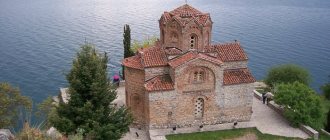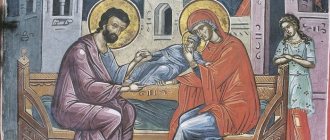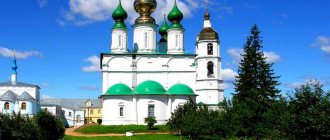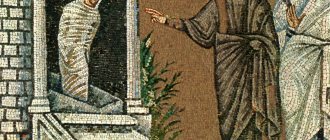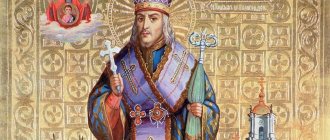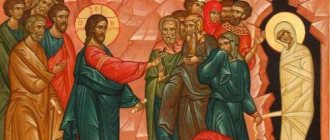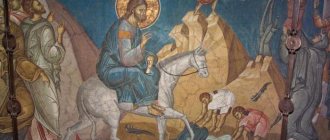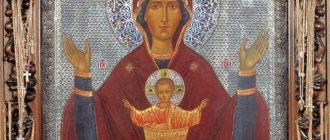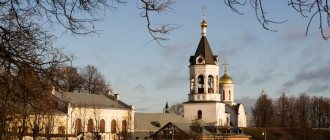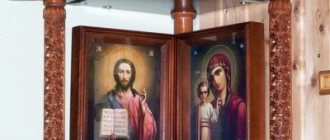When I was in the hospital, preparing for surgery (I had to remove the carbuncle, and everything was very bad for me - fever, chills, high temperature, and most importantly, not the most reassuring predictions from the doctors), my mother brought a small badge to the alley. The operation was successful and I was recovering.
At first I enjoyed life, and this - oh, happiness! — did not end so ingloriously. Then he looked carefully at the image of the Virgin Mary, which lay on the hospital bedside table among the packages of bottles. What is this image? It turned out that it was a copy of The Healer. Since then, I have been interested in miraculous icons, because I know: it is better to keep them with you in the hospital... And not only that!
Virgin of Eleusa (Mercy)
The miraculous icon of the Mother of God of Eleus was miraculously discovered.
This icon was underground for many centuries. It was hidden at a depth of 1.5 m. The history of this icon is very interesting. One day, the Mother of God appeared to 8-year-old Athanasius Syros. The boy was playing on the top of a hill with other children, but suddenly an unfamiliar barefoot woman dressed in a black robe approached him. She repented on a hard, dry place. After that, the ground became soft, like dough, and pulled the stranger into it. It was very pleasant to be at those points where the woman prayed. When Afanasy told the adults about this, no one believed him. That same night, the same woman again appeared to the child in a dream. She had a bright halo on her head. She told the boy that she was the mother of Christ. The Mother of God ordered to find an icon in the ground in the place where she prayed. She said that a temple should be built there. The next morning Afanasy told his parents everything, but again no one believed him. The boy decided to build a church on his own in the place where he saw the Virgin Mary. The mistrust of the villagers continued until 1962.
One day, land work began to be carried out on the village streets. After their completion, local residents asked workers to carry out excavations at the site of the prayer of the Virgin Mary. And a miracle happened. The icon was discovered under the roots of an old oak tree. This is how an image appeared with the inscription: “Our Lady of Eleusa. This icon dates back to the period of iconoclasm. Despite the fact that it lay in the ground for several centuries, the icon was well preserved. A larger temple was built on this site. A large number of pilgrims flock there every year.
The miraculous image of the Blessed Virgin Mary, called “The All-Tsarina”
Church of All Saints, Krasnoselskaya metro station
So the icon stayed on Mount Athos in one of the ancient Greek monasteries of Vatopedi. In 1995, at the request of the Community of Mercy in honor of the holy righteous John of Kronstadt at the Moscow Children's Oncology Center, the first list of the “All-Tsarina” icon was made for Russia. With the blessing of the rector of the Vatopedi monastery, Archimandrite Ephraim, the image was painted by a Russian icon painter, who was one of the brethren of the monastery. In Russia they loved this image. The cancer center held prayer services for sick children and their parents.
It was here that many suffering people were shown miraculous help and the speedy intercession of the Queen of Heaven. In 1997, the famous icon was transferred to the Moscow Church of All Saints.
“The Tsaritsa” is famous both on Athos and far beyond its borders. The special gift of grace from this icon is manifested in healings from one of the most common serious diseases of our time - oncology. There are countless cases where people with cancer were healed after a prayer service in front of the icon of the Mother of God “The Tsarina of All.”
Vladimir Mother of God
Vladimir has one of the most famous miraculous icons in Russia. It is connected with the Russian people, with its origins. It is believed that this icon was painted by the Evangelist Luke. It was in Jerusalem until 450, and then it was transferred to Constantinople. Patriarch Luke Chrysoverg presented the icon to Russian Prince Yuri Dolgoruky, who placed it in a convent in Vyshgorod.
In 1155, Prince Andrei Bogolyubsky transported the icon to Vladimir, where he placed it in the Church of the Dormition of the Vladimir Mother of God. The precious icon was in Vladimir for three centuries. Many miracles are associated with it. She didn’t even die in a fire when the Mongol horde raided Rus'. Our Lady of Vladimir accompanied Prince Andrei in battles against the enemy peoples of the Volga Bulgars, seeking to seize Russian lands.
During Tamerlane’s attack on Moscow in 1395, Prince Vasily Dmitrievich and Metropolitan Cyprian prayed, looking at the icon, for non-aggression. And a miracle happened. In 1395, Our Lady of Vladimir returned to the Church of the Assumption.
In a dream, Tamerlane saw a woman, accompanied by angels, hovering over the Russian army. Dream interpreters told the khan that this was the protector of the Russians, so Tamerlane decided to retreat. The icon also led soldiers to victories over the Tatars. Since 1918, the icon of Our Lady of Vladimir has been in the Tretyakov Gallery in the chapel.
Miraculous images of the Savior:
Jesus and the archangels help, first of all, to find faith and salvation of the soul. They ask him for help when they learn to live righteously, humbly, according to the commandments and without sin. Miraculous images of the Savior are able to cure diseases, give birth to a baby, improve relationships between spouses, and gain spiritual purity.
- Savior of Eleazarovsky - located in the Spaso-Eleazarovsky Monastery (Pskov);
- The Savior Not Made by Hands – Tretyakov Gallery;
- Savior Golden Robe - Assumption Cathedral (Moscow).
In the photo: carved icon of the Savior Not Made by Hands. See also other icons of the Savior.
Kazan Icon of the Mother of God (Lady)
The icon of the Kazan Mother of God was presented by Patriarch German II of Constantinople to the city of Kazan in the 13th century. This became protection against frequent raids. In 1438, Kazan was captured by the Tatars.
At the same time, the icon mysteriously disappeared. In 1579, the Kazan Kremlin was destroyed. Muslims believed that this was the wrath of Allah and the Prophet Muhammad. There was civil conflict in the city at that time, hatred and violence reigned everywhere.
However, the Virgin Mary did not leave the Kazan residents without help. She appeared to Matrona and indicated the place where the holy icon was buried. The girl told her mother and Saint Gury about this. Thanks to the girl Matrona, the miraculous icon was found. In 1579, the icon of the Kazan Mother of God was brought with honors to the Church of St. Nicholas.
Numerous miracles, including healings, are associated with this icon. In honor of her, the Russian Tsar, Mikhail Fedorovich Romanov, established two celebrations: July 8 in honor of her opening and October 22 in honor of the victory over the Poles. The icon of the Kazan Mother of God has become a symbol and protection of all Russians.
This icon was used to bless the marriages of Russian rulers. In 1904, the icon was stolen from St. Michael's Monastery. We managed to find only the frame. In 1917, a copy of this icon also disappeared.
The miraculous Tikhvin Icon of God
Temple of the Tikhvin Icon of the Mother of God, VDNKh metro station
On October 31, 1680, in the village of Alekseevskoye, north of Moscow, the new Tikhvin Church was solemnly consecrated: a religious procession with the Patriarch and Tsar Feodor Alekseevich went from the Kremlin to it. On the day of the consecration of the temple, the tsar presented it with the main shrine - the miraculous Tikhvin Icon of the Mother of God.
Surprisingly, the Church of the Tikhvin Mother of God in Alekseevsky did not close even during Soviet times. It also survived during the great Stalinist construction of VDNKh in that area.
According to modern legend, in 1941, during the German winter offensive on Moscow, it was from here that the miraculous icon of the Tikhvin Mother of God was taken, with which, by order of Stalin, it was flown around the city in an airplane. And soon the first successful offensive of the Red Army took place, ending with the capture of the city of Tikhvin. The celebration of the icon is set on June 26 (according to the Yulina calendar).
Virgin of the Lilies – Panagia Gravelyotissa
The Virgin of the Lilies is the miraculous icon of Panagia. She was miraculously discovered in the shepherds of Cephalia. In early August, the local ruler of Conte Lianu ordered all peasants to begin harvesting their vineyards. While working with a rake, one of the farmers caught the edge of a board. The man pulled it out and wanted to throw it away. However, seeing the image of the Holy Virgin, he ran to report this to his master.
But Llanos didn't even look at her. He ordered the icon to be sent to the Church of St. Demetrius. Llanos had a paralyzed daughter at the time, so he was not concerned about other problems. In the evening of the same day, the Virgin Mary appeared to him and asked him why he removed her image from the house? The man instantly woke up and ran to the temple for the Holy Image. He brought the icon home and presented it to his daughter. As soon as the girl looked at the image of the Mother of God, she slowly lowered her feet to the floor, stood on them and began to bow to the miraculous icon. From that moment on, the girl began to walk. Conte built the Church of St. Mary at the site of the discovery of the icon in memory of the miracle of healing. Mysteriously, lilies bloom every year in the Church of the Assumption of the Holy Virgin. Women collect them and place these bouquets in front of the icon. It is believed that when the Virgin Mary rises, then the dried lilies will come to life. After the liturgy, the priest distributes flowers to the believers every time.
Copies of miraculous icons. Wooden options for home iconostasis:
Copies of images recognized as miraculous are usually kept in home iconostases. Our wooden carved icons are also like a miracle: they are worked out to the smallest details, carved from solid wood, made with love, with prayer and according to all Orthodox canons.
We have taken upon ourselves the responsibility of restoring the ancient traditions of Russian Orthodox carved icons and offer you truly worthy options.
You can buy wooden icons in churches and cathedrals, a list of which is on the main page. You can also order a carved image of any Saint on our website or through any method of communication convenient for you: by phone, through social networks and instant messengers, via email.
Our Lady of All Who Sorrow, Joy of All Who Sorrow
This miraculous icon was miraculously found in the village of Klotsky near St. Petersburg. She was in a small church. At the beginning of the 19th century, lightning struck the church and burned it down. The icon miraculously managed to survive. Then, incredibly, coins from the benefactors' casket got stuck in the icon. The icon began to work miracles. Patriarch Joachim had a sister.
In 1688, she prayed for salvation from a long incurable illness that tormented her. Suddenly she heard a voice telling her to go to the Temple of the Metamorphosis of the Son of God. There she was supposed to find an icon called “The Joy of All Who Sorrow.” The voice told her that after this Euphemia would get better. The young woman did just that. The miracle of healing occurred on October 24, 1688 according to the Orthodox calendar. Now this day is considered an Orthodox holiday.
Financial difficulties
If a hole has formed in your wallet, loans and mortgages are strangling you - don’t give up. The most important thing is to keep working. And ask for help from the miraculous icons of saints who patronize financial well-being.
Saint Spyridon of Trimifuntsky served as a bishop and was a famous philanthropist - he always tried to help people with financial problems.
— Church of John the Baptist in the village of Klyuchishchi, Republic of Tatarstan
— Church of the Resurrection of the Word on Uspensky Vrazhek
— Temple of St. Sergius of Radonezh in the Vysoko-Petrovsky stauropegial monastery in Moscow
— Trinity Cathedral, Danilov Stavropegic Monastery in Moscow
Reverend Joseph, abbot of Volokolamsk , is famous not only as a clergyman, but also as a successful manager: he organized a monastery in Volokolamsk.
— Skete of All Saints of the Joseph-Volokolamsk Monastery in the village of Teryaevo, Moscow region
— Pafnutev-Borovsky Monastery in the Kaluga region
The icon of St. Nicholas the Wonderworker will bring you success in trade and financial matters. Even during his lifetime, the saint patronized merchants and gave his inherited fortune to charity.
— Cathedral of St. Nicholas the Wonderworker in St. Nicholas Monastery of Kaliningrad
— Church of St. Nicholas the Wonderworker in the village of Byngi, Sverdlovsk region
— Church of St. Nicholas the Wonderworker in Privolzhsk, Ivanovo region
— Church of St. Nicholas the Wonderworker in Veliky Ustyug
— Church of St. Nicholas the Wonderworker in Dmitrievsky, Stavropol Territory
— Church of St. Nicholas the Wonderworker in Podkopayi in Moscow
— Naval Cathedral of St. Nicholas the Wonderworker and Epiphany in St. Petersburg
"IZVOD"Digital iconography studio
Unusual and rare Orthodox icons.
The icon is a visible reminder of God's presence in our material world. The first icons have been known since the earthly life of Jesus Christ. “In ancient times, God, incorporeal and without form, was never depicted. Now, when God appeared in the flesh and lived among people, we portray the visible God,” John of Damascus once said. According to legend, the tradition of painting holy icons was introduced by the Lord Himself, sending His most pure Face to the ailing King Hagar, imprinted on the lining after He wiped off the water with it. The Most Holy Theotokos, with Her blessing, was painted by the first icon painter, the Apostle Luke, and the tradition of depicting saints on icons dates back to slightly later times and is closely connected with the science of hagiography.
Numerous Ecumenical Councils since the first times of Christianity have gathered prominent theologians and philosophers under their roof. A frequent practice of such meetings became a topic that worried the minds of the majority - whether it was permissible to paint images of Almighty God on canvases and boards, and, if so, in what form. The Council of Trulla (5-6) prohibited any image of the Lord other than His human essence, since He revealed this hypostasis Himself, thereby blessing future icon painters. But already in the 8th century, the Church fell into heresy, carried away by the dangerous trend of iconoclasm, and only at the 7th Ecumenical Council, the role of the icon was strengthened by the approved Dogma on icon veneration.
In the early Middle Ages, the Western and Eastern churches, not finding common ground for further joint development, diverged. From this moment on, the understanding of the icon also differs. It is difficult for the wild and simple barbarians who conquered the entire West to understand the subtle sublimity of the spiritual painting of Byzantium, where it is much easier to see the tangible statues of numerous saints and paintings on Christian subjects. Western Christianity was formed in the only way possible for those conditions and times.
Eastern Christianity continued to follow its complex path of spiritual development. The knowledge of the leading theologians of Byzantium, accumulated by long asceticism and deep faith, formed a single iconographic canon, used by the Orthodox Church to this day.
The Trinity of Andrei Rublev, the Savior Pantocrator, the Icons of the Mother of God: Kazan, Vladimir, Don, all kinds of amazing faces of saints - all these are the creations of different iconographic periods, different talented masters. So different, but at the same time united, we know a lot about them, we often see them in everyday life: in the decoration of churches, in the red corner of the home iconostasis. These are familiar icons to which millions of prayers are offered every day. But there are holy images about which we know very little, and sometimes nothing at all. Today I would like to introduce our reader to some of these unusual icons of the eastern canon.
***
Let's start with the iconographic image of the Triune God "Trinity of the New Testament" , which was divided into seven independent icons, the canonicity of which is still debated. It is believed that a similar plot appeared at the junction with Western art. The Apostle John the Theologian said that no one has ever seen God, of course, we are talking about God the Father. The essence of God the Son was revealed through Jesus Christ; accordingly, all canonical images of the Trinity must be written through the image of the Son, which is not observed in this iconography.
- Co-throne An icon depicting God the Father on the right hand, in the form of a gray-haired old man in shining robes, on the left hand is written God the Son in the familiar image of Jesus Christ the Almighty King, in the middle hovers God the Holy Spirit, symbolically depicted in the form of a Dove with the light emanating from Him.
- Fatherland In this icon, God the Father, seated on the throne, again appears in the form of an Elder in shining robes, on His knees He holds the Infant Christ (iconographic type Emmanuel), Who, in turn, holds a ball of light in the center of which is God the Holy Spirit .
- The All-Seeing Eye of God An unusual icon, full of deep meaning. In the center of the spherical image symbolizing the Universe is the God-Son of the iconographic type Emmanuel, from Him with four diagonal rays emanates a radiance pointing in four directions to the four tetramorphic (lion, bull, eagle, man) Apostles (presumably the 4 cardinal directions in which there were Gospel spread). In the segments of the second sphere of the circle, the features of the divine Face are depicted, in the third sphere, most often, the starry sky is depicted in the center of which the Most Holy Theotokos with outstretched arms like Oranta, the last circle is crowned by the image of God the Host and the highest fiery angels.
The remaining icons of the “Trinity of the New Testament” iconographic series , such as the Crucifixion in the bosom of the Father, Hosts, the Only Begotten Son and Word of God, the Sixth Day , are practically not recognized by modern figures of theology. Most saints and Orthodox philosophers are convinced that there is a strict prohibition on images of God the Father.
***
In addition to the Holy Trinity, there are unique icons of the Lord Jesus Christ, for example, the Creator of the Life and the Savior of Good Silence.
- The Creator of the Belly is a relatively modern image of Jesus Christ, depicted in the canon of the Pantocrator, outwardly reminiscent of many icons of the Savior in this iconography, but with one difference: instead of the Gospel in his left hand, He holds a human baby, or rather the germ of a born life - an embryo. The icon tells us that any life on earth is predetermined by God's Will. The image of the Creator of the Belly patronizes medical workers and helps babies be born.
- Savior the Good Silence is a very unusual and beautiful icon of the Lord. On it the Son of God is depicted as a beautiful Angel. “The Lord Almighty... was, is and is to come,” wrote John the Theologian in his Revelation. This image is surprising in that it does not refer to the earthly human incarnation of Christ; it is the pre-eternal step before the Birth of the Savior into the world. Icon of the Savior Good Silence is the Lord who was, the Savior Not Made by Hands and the Almighty is the Lord who is, the Savior in Power is the Savior who is coming during the Last Judgment. Nevertheless, all these states are simultaneously and eternally present in God.
***
There are quite a lot of icons of the Most Holy Theotokos, but in our conversation we will touch upon two rare and very tender iconographic images of the Mother of God.
- The first icon that I would like to talk about was revealed in Georgia, in the Dibri monastery during the restoration of ancient frescoes, and is called the Non-Idle One, or the Womb of the Divine Child . On it, the Mother of God was written during the period of bright anticipation of the Infant Christ. This is a story from the pages of the Holy Gospel, which tells how the holy righteous Joseph learned that the Virgin betrothed to him “was with child of the Holy Spirit” and wanted to secretly release Her (Matthew 1:18-19). The Mother of God stands with her right hand raised to her head, wiping away tears, and with her left hand she points out to Joseph that “she does not know her husband” and is a Virgin (Luke 1:34). The ruling bishop of the Russian-Urbnis diocese of the Georgian Orthodox Church, Metropolitan Job (Akiashvili), gave his blessing in 2001 to write a list of the “Non-idle” icon depicted on the fresco, which was done by Hieromonk John Okhanashvili. In front of the icon they pray for the gift of children and their health.
- The second rare image of the Blessed Virgin Mary is called The First Steps . The most unusual detail of this icon is that Christ, the Son of Mary, is no longer a baby, as we are accustomed to seeing him in classical iconography. The Savior is written by a touching child who takes his first steps under the close attention of a caring Mother. He extends His arms to Her, and she carefully insures Him in his first attempts at independent steps. This is a very gentle image, full of tenderness. Before the image, they pray for the children, asking the Queen of Heaven to protect them and protect them from all evil.
***
Iconographic images of saints have appeared since early Christian times. The apostles and martyrs are the first to be depicted after God and the Virgin Mary. Currently, the iconography of saints includes more than 1000 images. Here are some of them that are little known to modern Orthodox Christians.
- The Holy Martyr Christopher Pseglavets is a saint unjustly forgotten by the modern world. Perhaps it was forgotten because of its unusual iconographic appearance. On the icon the saint is written with the head of a dog. Of course, this image is symbolic. There are several explanations for the zoomorphic image: the first says that, captured during the battle by the Romans, a wild native of the Berber tribe (which is located in Egypt) was so strong and ferocious that he looked not like a person, but like an animal. The second interpretation of the image comes from the opposite - a certain Berber warrior, who bore the name Reprev before baptism, was so stately and beautiful that he could not avoid a sinful life, then he, having believed in Christ, begged God to disfigure him beyond recognition. God heard the prayers of His servant and made his face like the muzzle of an animal.
At the end of his life, the saint performed many miracles and led pagans to the true faith. For this, Emperor Decius Trajan hated him and ordered him to be brutally tortured. The torture was unsuccessful, and the martyr had to be beheaded. This is the amazing life of the early Christian saint, and no less amazing is his iconographic image.
There were many opponents of painting icons with a dog's head. One of them, for example, was St. Dmitry of Rostov. At his request, a case was even opened in the Holy Synod, but it never got off the ground, and this problem was not officially resolved. In some churches, the image of St. Christopher was painted with a human head, and in some shops they continued to offer believers the original version with an animal head, which testifies to us the diversity of religiosity of Russian believers in the 17th-19th centuries.
- Metropolitan of Beijing and the Cathedral of Chinese Saints
The priest, the great catechist of the Chinese people, was martyred by terrible torture during the Boxer Rebellion in 1900, along with 70 Orthodox Christians. He lived his life modestly and quietly, often bearing insults and insults. In 1879, obeying the instructions of Archimandrite Flavian (Gorodetsky), he accepted the priesthood. To the Russian eye, the icon of the Hieromartyr Mitrofan of Beijing looks unusual, but is fully consistent with the Eastern Orthodox canon.
- The icon of the prophet Jonah released from the belly of a whale is a very rare icon; to look at it you need to walk through more than one city. The icon depicts an Old Testament story. The Lord called His prophet to go to the sinful city of Nineveh and preach the true faith there. However, the prophet Jonah did not want to fulfill the will of God; instead, he decided to sail on a ship on a long journey. The Lord got angry and ordered the elements to teach the rebellious man a lesson. Sent a terrible storm. Jonah understood the will of God, but it was too late. Then the prophet ordered to throw him out of the ship; as soon as this was done, the storm calmed down, but the misfortunes did not stop there. A giant whale swam out of the abyss of water, which, by order of the Most High, swallowed Jonah. For three days and three nights the prophet cried and prayed to the Lord to have mercy and release him from the belly of the whale. The Lord heard and forgave. The whale disgorged an intact Jonah onto the shore. Praising God for his mercy, the prophet Jonah went to Nineveh. He converted many pagans to the true faith. Here is such an extraordinary image, serving as a reminder to us how important it is in this life to fulfill the Will of God and adhere to His Commandments.
Seven-shot icon
When a weak and sick peasant who appeared on the threshold of the temple declared that there was a “Seven Arrow” icon on the bell tower, the church servants did not believe him. Only on the third try was he allowed inside. No one expected that for many years everyone walked around the shrine. The peasant's words turned out to be true - the image of the Mother of God was found under the step of the stairs.
The seven-shot icon is an ancient shrine, the iconographic traditions of which vary. The most common option is where four arrows are pierced into the heart of the Mother of God on one side and three on the other. Other lists include a different arrangement of arrows and an image of Jesus. In any case, the icon is of great value to antique collectors.
Self-renewal of faces
Also inexplicable miracles are cases of miraculous renewal of faces. It lies in the fact that the colors on old, faded images themselves begin to become brighter, lighter, and faces appear clearly on them. This can happen at different speeds, sometimes slowly, gradually; sometimes the entire face is completely renewed at once. A well-known example of an update is the Kasperov icon.
The nature of such a wondrous phenomenon remains unsolved. Most often, this also happens on the eve of some unfortunate events. So, for example, a whole wave of cases of self-renewal of images occurred in our country at the beginning of the 20th century, especially on the eve of the most difficult years.
Cases of unusual intercession and healing
Many revered images have gained universal fame thanks to cases of unusual healing in serious medical cases. For example, many people know about such famous lists as “The All-Tsarina” (people pray before him even in cases of cancer), “Healer”, “Unexpected Joy”, “Life-Giving Source”, Kozelshchanskaya and many others.
In addition, no less number of holy images became famous due to their intercession in wars with foreign invaders. These are images that are well known to us: Vladimirskaya, “Znamenie”, Kazanskaya, Donskaya, Pochaevskaya, Vlakhernskaya and so on. Often such protection of the Mother of God was accompanied by many miracles: the appearance of the Mother of God in dreams and in reality, the flow of tears from her face, the return of arrows to the attackers themselves, and heavenly punishment.
Spas Loza Istinnaya.
The plot of the icon is based on the words of our Lord Jesus Christ from the Holy Scripture: “I am the true vine, and My Father is the vinedresser.” Grapes are a symbol of wisdom and greatness, and most importantly, they are a symbol of life, therefore the Lord in this icon is surrounded by a grapevine, symbolizing eternal life, and therefore the immortality of the soul. The Savior knows everything about everyone, he always hears the prayer of a believer, therefore he sends his gracious help. At the same time, Christ helps to understand and realize that no matter what earthly values and wealth collected by people, they are all perishable and empty in comparison with spiritual values, therefore, before this icon it is appropriate to offer prayers for repentance and strengthening in the Christian faith. In addition, in front of the icon of Jesus Christ “True Savior Vine,” you can pray for all the difficulties and problems that trouble your soul and heart, and, of course, for the healing of bodily ailments, mental wounds, and for good health for many years, because in During his earthly life, the Savior demonstrated to people that nothing was impossible for him and showed many miracles. For the icon of the Lord “True Savior Vine”, there is no special day for its veneration, since the Lord must always be remembered, prayerfully turn to his image with your problems and aspirations, thank him for the help provided, and for what we have, and then the Savior will send what a person truly needs.
Healing prayers for all diseases
Can healing prayers empower a believer to fight and overcome illness? Absolutely yes. The answer is clear.
A petition to the Lord or Saint changes a person’s worldview and fills the heart with warmth. And when love reigns in the soul, no troubles are scary - and evil recedes, it has no right to change anything.
When you put your soul into a prayer text, your appeal flies to heaven and does not encounter obstacles on its way.
The Holy Trinity
The authorship of this icon is attributed to Andrei Rublev. He worked on this image at the beginning of the 15th century, taking the Old Testament plot as a basis. According to ancient biblical records, one day Abraham met three strangers in an oak forest, whom he invited to a meal at his home. The travelers turned out to be angels sent by God. They talked about how in a year Abraham would have a son and a new generation would come from him.
This legend can be read almost entirely on the icon of the “Holy Trinity”. Only Abraham himself is not here. All attention is focused on the three angels bending over the cup of atonement.
Antiquarians also know other lists of this shrine, on which both Simon Ushakov and Alexander Svirsky worked. The icons are distinguished by details, which makes them recognizable and valuable in the eyes of collectors.
Icon of Seraphim of Sarov
The image of a gray-haired old man with his arms crossed on his chest is unmistakably recognizable to any Orthodox person. Seraphim of Sarov is depicted in this appearance on the icons of the same name. Iconographic traditions are not limited to this version of the saint’s spelling. There are lists where he is represented in a kneeling position on a stone, with a rosary or a staff in his hands.
The icon of Seraphim of Sarov cannot be called ancient. The first images appeared at the beginning of the 20th century after the hieromonk was glorified on the initiative of Nicholas II. But knowledge about the good deeds of the elder was known in Rus' long before this event. In the 19th century, it received many visitors, among whom was Tsar Alexander I and other noble persons.
Other rare phenomena
All the cases listed do not at all cover the inexhaustible multitude of miracles revealed in miraculous icons. Some images are imprinted on glass (for example, “Look at Humility” in Kiev), overgrown with flowers along the contour without a power source (the so-called “Kulevchansky miracle”), poisonous snakes crawl towards them and do not sting (on the Greek island of Kefalonia), they talk (“Consolation or Consolation” on Athos) or admonish blasphemers (“Slaughtered”, Kaluzhskaya).
As we see, most of the images glorified by miracles are of the Mother of God. This testifies to how much the Mother of God cares for us and pities us like no other person. It is interesting that not only the originals are venerated - all copies from glorified faces “automatically” also become miraculous.
Learn more about the unusual images of the Mother of God from the video:
The Last Judgment of God.
The spiritual image on this icon is one of the most significant and significant in Orthodoxy. The plot of this icon reflects the Biblical prediction about the second coming of our Lord Jesus Christ, about the resurrection of the dead and the Last Judgment of the Lord, in which sinners and righteous will be separated, each will be rewarded according to his deeds and his path will be determined, some to heaven and some to hell. This spiritual image amazes with its genius, beauty, number of large and small details, as well as the persons involved, which are mentioned in the Holy Scriptures. Christian chronicles have conveyed information to this day that says that this image appeared approximately in the 4th century after the Nativity of Christ. Many historians claim that the first image was not as rich as the modern one, so it was constantly improved, and only in the 8th century, the icon “The Last Judgment of God” became canonical. According to church belief, this icon came to Holy Rus' around the 10th century, and immediately became significant for Russian Orthodox believers, since the inhabitants of Rus' have always revered Scripture and the images depicted from it. Before the spiritual image on the icon “The Last Judgment of God,” it is appropriate to offer prayers, first of all, for the forgiveness of sins committed consciously and unconsciously, and also to ask for admonition and for help in resisting worldly temptations. It is customary to pray to the image on the bottom icon for repentance, since only repentance can save the soul and open the Kingdom of Heaven for the believer. The Church of Christ remembers the Last Judgment of the Lord for a whole week, which begins fourteen days before the Great Orthodox Lent.
